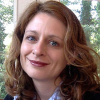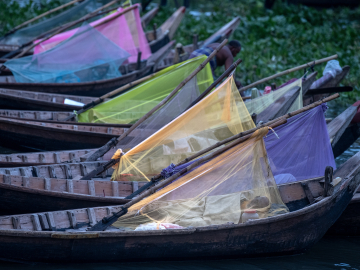Why Mycetoma? Q&A with Annie Liang and Simran Dhunna
Almost 8 months ago, we announced the winning nomination for the Untold Global Health Story of 2015 contest. Out of 170 nominations of diseases and issues that significantly impact global health but receive little to no attention from the mainstream media, one stood out: mycetoma, submitted by Annie Liang and Simran Dhunna, students at the University of Toronto. Annie and Simran’s entry led to the stunning 3-part series by Amy Maxmen about mycetoma in Sudan for Global Health NOW. In this Q&A, they share the moment they learned about mycetoma, and what motivated them to find a way to make the world care about this neglected disease.—Dayna Kerecman Myers
How did you first learn about the devastating disease mycetoma?
Liang: I first learned about mycetoma at the 67th World Health Assembly in Geneva, Switzerland. Before that, I’ve spent a significant amount of time in the tropical disease community. When I learned about mycetoma for the first time, it caught me by surprise to learn about diseases even more neglected than those on WHO’s list of “neglected diseases,” that I was unaware of despite my background.
How did you decide to enter mycetoma in the Untold Global Health Story of 2015 contest?
Liang: When I first heard of the Untold Global Health Stories Contest, I felt there was no better match in terms of unreported stories. One of my most haunting memories from WHA67 was the disappointment on the faces of the African health ministers when faced with an empty side event room, and the rows of mycetoma briefing papers laid hopefully on tabletops that went untouched.
That day, my delegation resolved to do everything possible to raise awareness of mycetoma. Just students at the time, we were thinking more small scale—factsheets about mycetoma and a “Mycetoma Awareness Day” synchronized among all our universities. Winning the Untold Global Health Story of 2015 and being able to bring international attention to a disease so neglected far exceeded our wildest dreams. A year ago, I don’t think any of us could have envisioned the scale it has since taken.
What do you hope will come out of the coverage on mycetoma this month?
Liang: First, more than anything, I hope that mycetoma will provide a face for the many more neglected diseases outside of the WHO’s list of 17 that remain unheard of, unnamed and may never reach the limelight. For example, jiggers (one of Global Health NOW’s honorable mentions) is a debilitating disease caused by chigoe fleas burrowing into exposed extremities prevalent among the street youth I work with currently in western Kenya. Like many other diseases of poverty and like mycetoma, it’s largely unknown, with no treatment, and it often affects the most vulnerable.
Second, the true heroes of these stories are really the people that come from these affected countries, who have travelled great distances at a great cost to lobby for the well-being of their people. I hope the narrative can remain on them and empower their own stories.
Dhunna: When people learn about neglected diseases, they are often exposed to a list of common “tropical” diseases that are both debilitating and disproportionately affect those living in poverty. But at the end of the day, that list is a set of words associated with clinical symptoms and a somber prognosis. So, I hope that this series will put some faces—actual stories of real human beings affected by this disease—to mycetoma. I hope that this coverage on mycetoma will, ultimately, pressure major stakeholders to take legitimate and comprehensive action on mycetoma and NTDs overall.
What do you want to accomplish in global health?
Liang: I want to work in the international development sector on civil society engagement and youth empowerment initiatives. I dream of an interconnected youth network(s) that transcends national boundaries, stands in solidarity for global health equity, and facilitates greater partnerships with students from LMICs. Some of us are lobbying for the inclusion of a youth voice in federal delegations, bridging the geographic gap between international global health student organizations, [etc.]. I want to work toward a more inclusive world.
As for NTDs, I’m currently assisting a WHO initiative looking at transformative education platforms and eLearning initiatives for NTDs across the different sectors. For the past 8 months I’ve been based in Kenya, one of the first countries in sub-Saharan Africa to launch a national plan to combat NTDs. Next, I’ll be backpacking through East Africa to scope out the region and logistical feasibility of collecting field stories on NTDs. Whether NTDs ends up becoming a future career or simply a passion, we’ll see.
Dhunna: The University of Toronto has a growing and passionate global health community, so being involved in some of our organizations in my first year really propelled me into a uniquely interdisciplinary field. While I am in a research-oriented microbiology program, the flexibility of the field of global health has allowed me to not only apply scientific knowledge, but also explore the broader socio-cultural and political forces that determine health outcomes. At the moment, I am interested in everything from antibiotic resistance to global governance. The future is uncertain for me right now, but there’s a sense of elation to that uncertainty that I am happy to indulge (at least until I graduate!).
Annie Liang is a Master of Public Health (Epidemiology – Global Health Emphasis) student at the University of Toronto. She currently sits on the North American Coordinating Committee of Universities Allied for Essential Medicines, the CUGH Trainee Advisory and is a Youth Ambassador for the Young Diplomats of Canada.
Simran Dhunna is an undergraduate student in her 3rd year at the University of Toronto, where she is studying molecular genetics and microbiology. She is also actively involved in global health initiatives on campus, including serving as managing editor of Juxtaposition Global Health Magazine and leading a recently-established neglected diseases student organization.
Please join the thousands of subscribers who rely on Global Health NOW summaries and exclusive articles for the latest public health news. Sign up for our free weekday enewsletter, and please share the link with friends and colleagues: Subscribe to GHN




